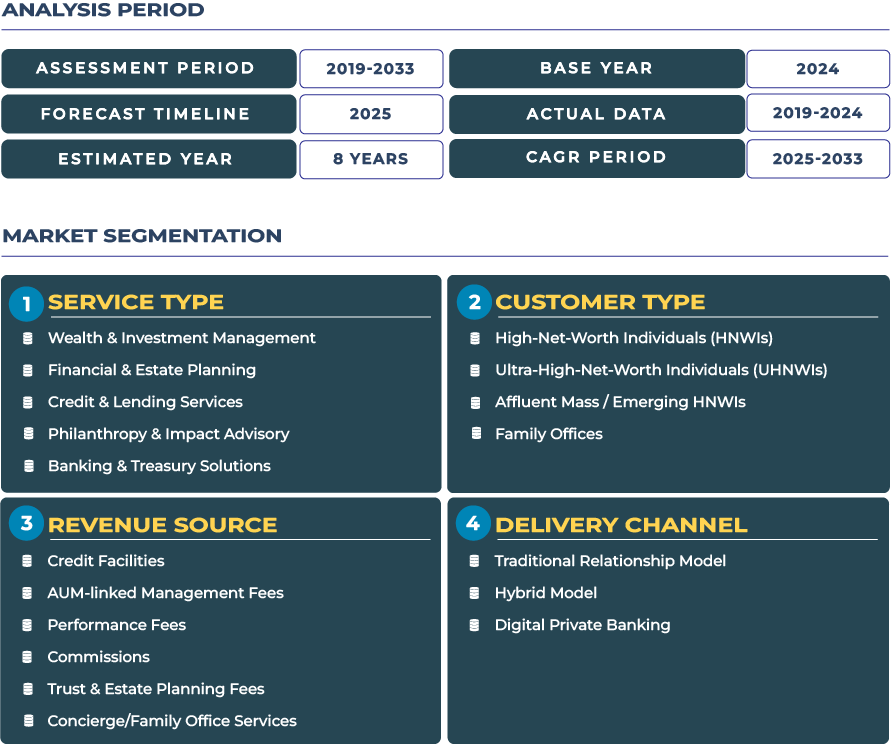North America Private Banking Market Outlook: Charting the Next Era of Private Banking
In an environment where the notion of “zero” underscores fresh beginnings and foundational shifts, the private banking ecosystem in North America is entering a pivotal phase. With wealth accumulation accelerating, governance expectations evolving and geopolitical volatility rising, the region’s private banking industry is being re-set rather than simply scaled.
Note:* The market size refers to the total revenue generated by banks through various services.
Against this backdrop, the North America private banking market is forecast to grow from USD 328.3 billion in 2025 to USD 428.3 billion by 2033, reflecting a CAGR of approximately 3.4 %. This baseline signifies the moment when private banking institutions must move beyond incremental change and embrace strategic reinvention: from deposit-led growth to integrated investment, from loan-centric models to multi-channel wealth ecosystems, from legacy payments and treasury operations to fully digital, client-centric offerings. The “zero” moment is thus about clearing the plate: creating a private banking platform designed for complex, affluent clients within a highly dynamic North American economy and geopolitical landscape.
Drivers & Restraints: Deliberating What Propels - and What Impedes - Growth
The key drivers in the North America private banking sector revolve around escalating wealth creation, digital acceleration, and client sophistication. First, the volume of U.S. and Canadian high-net-worth and ultra-high-net-worth individuals is growing, creating a larger addressable market. Second, affluent clients are demanding tailored investment services (including alternative assets), personalized lending, seamless payments and consolidated treasury capabilities-areas where private banks can differentiate. Third, institutions are leveraging digital platforms, AI-driven analytics and advanced credit solutions to improve service efficiency and client intimacy. Regulatory environments that emphasise transparency, ESG integration and risk control also work in favour of banks that invest early.
Nevertheless, several constraints temper the growth trajectory. Interest-rate volatility and macroeconomic uncertainty-especially in light of global conflicts or systemic shocks-raise risk perception among affluent clients and may suppress new asset flows. Elevated regulatory compliance costs and capital requirements can hamper banks’ ability to innovate rapidly. The fragmentation of client expectations across wealth tiers means banks must segment and scale offerings rather than adopt one-size-fits-all models. Also, competition from non-bank wealth-tech entrants and non-traditional lenders, particularly in payments and lending, threatens margin erosion. Finally, the operational complexity of managing integrated services-spanning deposits, loans, payments, investment, insurance and treasury-demands high investment in infrastructure and talent. For many private banks, the cost of transformation will pose a meaningful barrier.
Trends & Opportunities: Navigating Digital-First, ESG-Mandatory and Experience-Centric Landscapes
A major trend reshaping the North America private banking landscape is digital wealth transformation. The pandemic accelerated client expectations for mobile-first, omni-channel advisory, and real-time liquidity management integrated with investment and treasury services. Private banks are now migrating from legacy systems to platforms that embed payments, real-time lending decisions, digital trust/estate modules and seamless onboarding. Another trend is the integration of ESG and sustainability-aligned strategies into private wealth portfolios and bancassurance-linked services. Clients increasingly expect their private banking partner to reflect values and global sustainability priorities-leading banks are embedding ESG screening, impact investing and sustainability-linked lending into their proposition.
On the opportunity side, there is a strong uptick in demand for alternative investments, private credit, specialty lending and treasury-optimised solutions among affluent clients-especially as comparably low yields on traditional assets persist. Private banks that can offer structured credit, bespoke insurance/bancassurance wrappers, global real-estate or private markets access, combined with intelligent treasury use cases (e.g., liquidity across jurisdictions) will gain competitive advantage. Moreover, regional hubs within North America-such as Florida, Texas, California, and Toronto-are seeing growth in affluent demographics and provide opportunity for tailored local-market offerings. In sum, the interplay of digital, ESG and experience-centric capabilities defines the roadmap for the next generation of private banking in the region.
Regional Analysis by Country
United States
The U.S. remains the largest market for private banking in North America, driven by significant accumulation of wealth among HNWIs and UHNWIs and the maturity of its financial infrastructure. Demand for advanced investment strategies, integrated banking, concierge services and global access is high. That said, U.S. private bankers face pronounced headwinds from rising regulatory scrutiny, tax-policy uncertainty, and digital disintermediation by fintech challengers.
Canada
Canada’s private banking landscape is characterised by a stable economic and political environment, strong institutional trust and growing demand for cross-border wealth solutions (between Canada and the U.S.). Private banks able to bridge U.S.-Canada liquidity, lending and investment flows are well-positioned. Growth is moderated by the smaller market size and comparatively conservative credit dynamics.
Mexico
Mexico presents an emerging but increasingly important frontier for private banking firms targeting wealthy individuals in Latin-America’s northern corridor. Growth drivers include the rise of locally domiciled family offices, increased wealth repatriation and demand for investment and treasury solutions tied to U.S./Canada integration. Risks include currency volatility, regulatory fragmentation and geopolitical proximity to U.S. economy fluctuations.
Competitive Landscape: Strategic Maneuvres Defining the North America Private Banking Arena
Competitive dynamics in the North America private banking market are intensifying. Leading institutions such as JPMorgan Chase & Co. (via its J.P. Morgan Private Bank arm) are expanding tailored offerings across affluent segments, deepening branch and digital footprints, and aligning lending and investment capabilities for high-net-worth clients. For example, in September 2025 JPMorgan Chase announced the expansion of its Private Client offering to 53 additional branches across key states.
Strategy wise, banks are emphasising differentiated segmentation (e.g., ultra-HNW vs next-gen wealth), digital platform roll-outs, lean advisory models, and embedded services (insurance/bancassurance, treasury optimisation, payments). M&A and strategic partnership activity is also notable – mid-size players seek boutique positioning while large banks look for scale and global network. As geopolitical tensions and regulatory constraints mount, private banking firms are also reinforcing risk-management and cross-border capabilities to attract globally-mobile clients. The drive for operational efficiency (in wealth planning, trust/estate services, tech stack) is also accelerating, as margins are squeezed and clients expect higher personalization.








